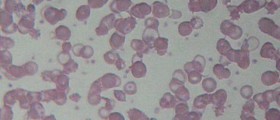
Sickle cell anemia or sickle cell disease represents an inherited blood disorder. It is a type of anemia, the condition characterized by decrease in number of red blood cells. Red blood cells carry oxygen from the lungs to the rest of the body as they are flexible, round and easily travel through the blood system.
However, in sickle cell anemia red blood cells are stiff and have abnormal crescent shape. Sickle cells can get stuck in blood vessels causing blockage which disrupts normal blood flow. Sickle cell anemia cannot be cured but the treatment is available to alleviate pain and manage the disease.
Symptoms of Sickle Cell Anemia
Symptoms of sickle cell anemia typically display after an infant reaches 4 months of age. Sickle cell disease is usually accompanied by anemia due to lack of red blood cells. Sickle cells are fragile and prone to rupture. Also, unlike healthy red blood cells, sickle cells live only for 10 to 20 days. Anemia causes weakness and fatigue. Paleness in people with sickle cell disease is also common.
Primary symptom of sickle cell anemia includes bouts of intense pain, called crises. Episodes of pain occur when sickle cells get stuck in blood vessels and block blood flow. Such pain develops in the chest, abdomen and joints. Pain crises may be of different frequency and severity, and sometimes require treatment in a hospital.
In infants, the first symptom of sickle cell anemia is usually swelling of the hands and feet. Frequent infections are also common in people with sickle cell anemia because the disease affects the spleen. To prevent life-threatening infections in infants and young children, the disease is treated with antibiotics.
Children with sickle cell anemia also suffer from delayed growth and damage to the retina which can cause vision problems and permanent blindness. Yellow appearance of the skin and whites of the eyes (jaundice), rapid heart rate, excessive thirst and frequent urination may occur as well. The legs of individuals suffering from sickle cell anemia are susceptible to ulceration. Osteoporosis, kidney damage and nervous system damage may also result from sickle cell anemia.
Prevention of Sickle Cell Anemia
Sickle cell anemia cannot be prevented. However, couples with sickle cell trait should go for genetic counseling before trying to conceive a child. Sickle cell anemia can be diagnosed in pregnancy. Measures to prevent sickling of red blood cells include keeping the body hydrated, getting enough oxygen and treating infections promptly.
- medlineplus.gov/magazine/issues/winter11/articles/winter11pg18.html
- www.cdc.gov/ncbddd/sicklecell/index.html
- Photo courtesy of National Human Genome Research Institute by Wikimedia Commons: commons.wikimedia.org/wiki/File:Sicklecells4.jpg

















Your thoughts on this
Loading...